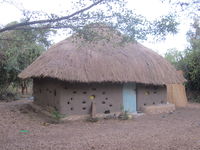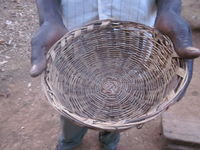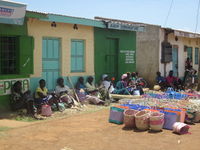Yala Swamp
Yala Swamp is a "vast wetland protecting the mouth of the Nzoia River and the north-eastern shore of Lake Victoria in Kenya. Lake Kanyaboli, which still shelters some of the fish species that have disappeared from Lake Victoria, is part of the Yala Swamp complex.
"The swamp's large stand of papyrus reeds and other sedges collect water during the rains, stabilizes the muddy soil, traps sediment and filters pollutants. These ecological services help to keep Lake Victoria waters clear, reduce soil erosion and minimize the impacts of floods."[1] It is also home to a number of bird species, including papyrus endemics - birds only found in papyrus swamp habitat. However, currently Yala Swamp is being converted into a massive industrial agricultural operation by Dominion Farms Limited, an Oklahoma-based company that produces rice, bananas, and tilapia. Yala Swamp is located in Siaya District, Nyanza Province and Busia District, Western Province.[2] Ramogi Hill, a sacred site to the Luo people, is contained within the swamp.
Contents
Socio-Economic Value
- "Kenya's wetlands, covering 14,000 km2, are a resource of great social-cultural and economic potential (Gichuki, 1990). Many of Kenya's rural communities draw food, medicinal products, fuelwood, materials for building and handicraft from wetlands. However, these ecosystems are today facing a serious threat to their continued existence from encroaching human development activities, especially agricultural operations."[3]
Ceremonial Uses In the region of Yala Swamp and the Nzoia River, the Bukusu subgroup of the Luhya people traditionally use secluded areas within wetlands for circumcision ceremonies, in which young men "smear themselves thoroughly with mud, and then walk naked back home."[3]
Hunting and Gathering Both the Luo and Luhya people use wetlands to hunt birds and other wild animals. "According to Ogutu (1987) the points at which the Rivers Yala and Nzoia enter Lake Victoria were swampy and bush enough for the water-related beasts to inhabit, thus, the hunters could easily lay traps in these concealed areas for big animals, such as the Hippopotamus 'rawo' (which were fairly numerous in olden days), or small rodents such as 'anyier'."[3] The Nyala people also hunted Sitatunga antelope and wild pigs for food. The Luhya people mostly trapped birds, including those found in wetlands. Most of the materials for making basket traps and cages for birds also came from the wetlands (papyrus, bulrushes).
Local people also gathered materials to construct beehives within the wetlands, and honey was then used for local brews and medicine, as well as for food. The Luo and Luhya people also gather wild greens, especially during the dry season, from the wetlands. For example, the Luhya gather 'enderema' and 'lubiliabilia,' which were also used to "cure certain ailments of the stomach."[3] "The fact that land was commonly owned meant that one could collect fruits and vegetables that grew on wetlands without restriction. The changing land ownership system that encourages privatisation of land has somehow reduced the importance of gathering wild greens."[3]
Building Materials
Traditional homes near Yala Swamp are constructed of mud with thatched roofs. Traditional style mud homes keep a family cool during hot days and warm at night. They are also biodegradable, which serves a purpose as the Luo people traditionally do not inhabit the homes of the dead. As some switch to building non-biodegradable homes of brick and metal, the tradition of not moving into the homes of the dead results in many abandoned, erect, non-biodegradable houses.[4]
- "In building construction, clay of different types was used for plastering the walls and floors of houses (Odak, 1987). The clays varied depending on the local availability but those obtained from wetlands were usually preferred (O. Abok, pers. comm.) Such clays have also been used extensively in providing commodities such as pots of different types and sizes and smoking pipes (Odak, 1987).
"The herbaceous vegetation from marshes was traditionally harvested with the clay and used in the construction of houses and granaries. Traditional Luhya houses, for example, had walls constructed from a framework of sticks or reeds and the roof was assembled separately from reeds or maize stalks tied to rings of grass or split palm leaves (Were and Soper, 1986)."[3]
Other uses of twigs and grass from the swamp are basket and mat making. "The popular 'marachi' sofas are made from 'amaduru' reeds and branches of the 'isiola' tree. They are often coloured with natural black and yellow dyes made from the water plant 'litodo' (Were and Soper, 1986)."[3]
As of 2012, some Kenyans living near Yala Swamp continue to utilize grass thatching to construct roofs, although those with enough money sometimes opt to use corrugated iron sheets instead.[4]
Fishing Fishing for domestic consumption and for sale is also a traditional use of the Yala Swamp.[3] Traditionally, wetlands were also used as sources of materials to make fishing equipment. For example, the Luhya weave reeds in conical patterns to construct basket traps known as 'evisu' and 'omukono.' Another fish trap is the 'olukhwiro,' which is made of a fence of reeds tied together with papyrus stems that is fastened to fence posts. The Luo also use reeds and papyrus stems to make the 'sienya' basket trap.
Livestock Some people who inhabit the areas near Yala Swamp use the area to graze their livestock.
Species Found in Yala Swamp
Bird species include:[1]
- Papyrus Gonolek (Laniarius mufumbiri)
- Papyrus Yellow Warbler (Chloropeta gracilirostris)
- Papyrus Canary (Serinus koliensis)
- Carruthers's Cisticola (Cisticola carruthers)
- White-winged Swamp Warbler (Bradypterus carpalis)
- Great Egret (Casmerodius albus)
- Baillon's Crake (Porzana pusilla)
- Great Snipe (Gallinago media)
- White-winged Scrub-warbler (Bradypterus carpalis)[5]
- Sharpe's Pied-babbler (Turdoides sharpei)[5]
- Red-chested Sunbird (Nectarinia erythrocerca)[5]
- Northern Brown-throated Weaver (Ploceus castanops)[5]
Fish species include:[1]
- Singidia Tilapia (Oreochromis esculentus)
- Victoria Tilapia (Oreochromis variabilis)
- Cat fish (Clarias gariepinus)
- Lung fish (Protopterus aethiopicus)
Mammal species include:[1]
- Sitatunga Antelope (Tragecephalus spekii)
- Vervet Monkey (Chlorocebus pygerythrus)
- Spotted-neck Otter (Hyrictis maculicollis)
- Bush Pig (Potamochoerus larvatus)
Articles and resources
Related SourceWatch articles
References
- ↑ 1.0 1.1 1.2 1.3 "Yala Swamp: Important Bird Area," pamphlet by Nature Kenya.
- ↑ Leon Bennun and Peter Njoroge, Important Bird Areas in Kenya, BirdLife International, 1999.
- ↑ 3.0 3.1 3.2 3.3 3.4 3.5 3.6 3.7 R.W. Kareri, "The Sociological and Economic Values of Kenya's Wetlands," Wetlands of Kenya: Proceedings of a Seminar on Wetlands in Kenya,S.A. Craftter, S.G. Njuguna and G.W. Howard (Eds), 1992, p. 99-107.
- ↑ 4.0 4.1 Jill Richardson, visit to Bondo District, Nyanza Province, Kenya, February 20-24, 2012.
- ↑ 5.0 5.1 5.2 5.3 Yala Swamp, BirdLife International, Accessed February 25, 2012.
External resources
- Community Conservation of Yala Swamp, Kenya, National Committee of the Netherlands.
- Yala Swamp, BirdLife International.
- Wetlands of Kenya: Proceedings of a Seminar on Wetlands in Kenya,S.A. Craftter, S.G. Njuguna and G.W. Howard (Eds), 1992. Wetlands of Kenya. Proceedings of the KWWG Seminar on Wetlands of Kenya, National Museums of Kenya, Nairobi, Kenya, 3-5 July 1991. vii + 183 pp. The IUCN Wetlands Programme
External articles
- "Yala Swamp Important Bird Area Conservation Management Plan," Version 1, UK Department of Environment Food and Rural Affairs Darwin Initiative, October 2009.
- Gichuki, N. 1990. The ecological and socio-economic aspect of conservation and management of wetlands as bird habitatsin Kenya. A Research project proposal. World Wildlife Fund. Nairobi, Kenya. 37 pp.
- Ochumba, PBO and DI Kibaara, 1989. Observations of the green algal blooms in the open waters of Lake Victoria, Kenya. Afr J. Ecol 27:23-34.
- Mavuti, K.M. 1989. Ecology of the Yala Swamp. Resources 1:11-14.
- Okondo, P. 1989. The Yala Swamp is Useless. Resources 1:16-19.
- Lake Basin Development Authority. 1989. Reclaiming the Yala Swamp. Resources 1(1):9-11.
- Odak, O. 1987. Material culture and design. Pages 242-263. In: Republic of Kenya, (1987) Siaya District Socio-cultural Profile. Ministry of Planning and National Development and Institute of Agricultural Studies, University of Nairobi, Kenya.
- Ogutu, M.A. 1987. Fisheries and fishing. Pages 86-105. In: Republic of Kenya, (1987) Siaya District Socio-cultural Profile. Ministry of Planning and National Development and Institute of Agricultural Studies, University of Nairobi, Kenya.
- Were, G.S. and R. Soper (Eds). 1986. Kenya socio-cultural profiles Busia District. Ministry of Planning and National Development and Institute of Agricultural Studies, University of Nairobi, Kenya.
| This article is a stub. You can help by expanding it. |


